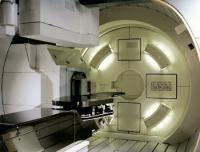Progress in Health: Trending Treatments for Rare Diseases
 Proton beam therapy
Proton beam therapy
By offering financial incentives to manufacturers, the FDA hopes to see more treatments for rare diseases reach the approval stage much faster.
by Jon Dawson
People suffering from rare diseases often find themselves up against a wall when it comes to treatments for their conditions. The National Institutes of Health indicates that a disease is rare if it affects less than 200,000 Americans. To date, scientists have found over 7,000 of these diseases. Because they are rare, insurance companies, pharmaceutical companies and the FDA have been less motivated to find treatments in the past. But this is beginning to change; people suffering from rare diseases are finding more people who are eager to solve these issues, researching and promoting possible treatment options.
Targeted Radiation Providing Hope for Chordoma
One such rare disease is chordoma, a slow growing bone tumor that is often resistant to radiation. These tumors tend to be found in the spine near the cervical or sacral areas. Surgery is the primary treatment option, providing the tumor has not begun to spread; but because of the sensitive location surgery isn’t always possible.
Proton therapy, a newly popular treatment which allows for a higher dose of radiation to be targeted directly to the tumor, is proving to be an effective way to treat chordoma. There are relatively few proton therapy centers in the United States, and the Indiana University Health Proton Therapy Center was the first center in the Midwest and Great Lakes regions. The combination of a high level of radiation and the accuracy of the treatment allows proton therapy to be a successful treatment for this condition when surgery isn’t an option.
Gene Therapy May Treat Rare Blood Disease
Gene therapy is another player in the treatment of rare diseases. Patients with hemophilia B, a rare blood-clotting disorder caused by a defective gene, are seeing promise from injections containing the correct form of the gene.
Gene therapy isn’t a new treatment, but over the past two decades it’s been met with a series of failures. The genes must be injected into the body via a virus, and the human immune system seems to be too effective at eliminating the virus before it can offer up its healthy genes. But in recent studies on hemophilia B patients, it appears gene therapy may be effective, as reported by The New York Times. Much more studies need to be done before this will be mainstream therapy for the condition, but for those who had little hope of a cure, this is promising research.
FDA Approval Proves Difficult
When patients face a diagnosis of a rare disease and a potential treatment option, it’s often the FDA that stands in the way of potential treatments. For example, eight-year-old twins Addison and Cassidy Hempel suffer from a rare disease called Niemann Pick Type C, which mimics Alzheimer’s disease in adults. Without treatment, the disease is eventually fatal.
The twins’ parents have been advocating tirelessly in hopes of finding a cure for their daughters and save their lives. When they found a treatment that was being studied on mice, they had to go through a huge amount of red tape in order to get FDA approval to try the medication on their girls. When the first trial did not work and a new delivery method was needed, they had to go through the process once again.
While these stories aren’t uncommon in the world of rare diseases, the FDA is trying to make changes: they’re recommitting the agency to spend time and money on developing cures for rare diseases, while eliminating some of the red tape that people pushing for approval must go through in order to get the treatments they need. By offering financial incentives to manufacturers, the FDA hopes to see more treatments for rare diseases reach the approval stage much faster. For patients and families like the Hempels, this is welcome news.
A diagnosis of a rare disease is life changing, but today patients and their families have even greater treatment options at their disposal and a government that is more willing to work with them. As medical technologies continue to advance, the outlook for those suffering from rare diseases is going to continue to improve. For around one in 10 Americans with a rare disease diagnosis, this is very exciting.
Jon Dawson is an attorney and professional writer living in Indianapolis. He blogs about law, technology, and health matters.



 del.icio.us
del.icio.us Digg
Digg












Post your comment